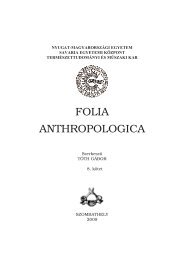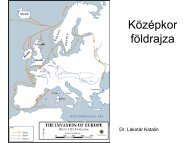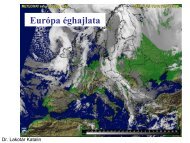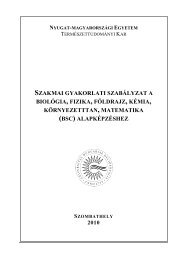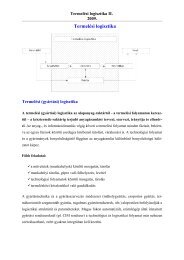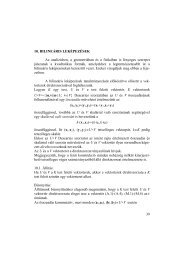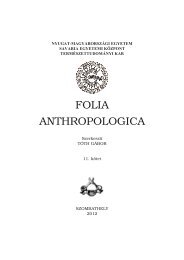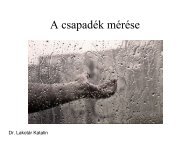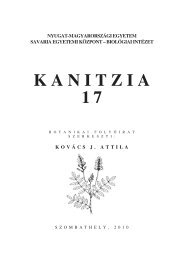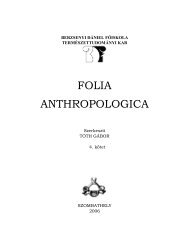Kanitzia 18. - NYME Természettudományi Kar - Nyugat ...
Kanitzia 18. - NYME Természettudományi Kar - Nyugat ...
Kanitzia 18. - NYME Természettudományi Kar - Nyugat ...
Create successful ePaper yourself
Turn your PDF publications into a flip-book with our unique Google optimized e-Paper software.
strongly related to the other disturbed steppic vegetation units, and also to the dry- and<br />
semi-dry grassland communities in Transylvania, but differing basically from them by the<br />
dominancy of the character species (K. ceratoides A-D: 12-75%, Agropyron cristatum A-<br />
D: 5-35%), by special/narrow habitat conditions, its role in the vegetation succession and<br />
relationships, being one of the ancient community type which probably persists continously<br />
from the early Holocene survived as relic enclaves in the vegetation of Transylvania.<br />
2. Bothriochloetum ischaemi (Kristiansen 1937) I. Pop 1977 (Table 2)<br />
Dry grasslands dominated by Bothrichloa ischaemum (Andropogon ischaemum)<br />
with the coenotic participation of K. ceratoides (A-D: 1-12%) were identified near Vultureni,<br />
Groapa Rădăii and Poiana Frăţii (Table 2, Fig. 2). They occur as mosaic-like microsites<br />
of warm southern slopes with high inclination (20-40%), sunshine places, eroded<br />
slopes, ancient landslides and very often abandoned fields. The anthropogene influences<br />
(once pasturing) and the site disturbancy is more evident also. Coenotic relations with the<br />
former plant community is presented by the characteristic species of the alliances<br />
(Agropyon cristatum, Artemisia campestris, Artemisia pontica, Brassica elongata, Astragalus<br />
mosnspessulanus, Vinca herbacea, Linum austriacum; Agropyro-Kochion s.l., Festucion<br />
rupicolae) but in the vegetation structure with high constancy value several<br />
xerothermic generalist species participate: Festuca rupicola, Elymus hispidus, Stachys<br />
recta, Jurinea mollis, Cleistogenes serotina, Phlomis tuberosa, Astragalus onobrychis, Poa<br />
angustifolia, Salvia nemorosa, Euphorbia cyparissias (Festucetalia valesiacae, Festuco-<br />
Brometea). Relationships with the fringe communities and the semi-dry grasslands are indicated<br />
by the frequency of the following species: Galium glaucum, Agrimonia eupatoria,<br />
Bupleurum falcatum, Brachypodium pinnatum, Dorycnium herbaceum etc.<br />
The presence of ’variae syntaxa’ and weeds like Daucus carota, Achillea millefolium,<br />
Elymus repens, Melilotus officinalis, Plantago lanceolata etc. indicate a kind of<br />
ruderalization of this community mentioned formely by SOÓ (1945), who considered it initially<br />
as an „Agropyron intermedium-Andropogon ischaemum” grassland type, (Vultureni)<br />
for which afterwards proposed just a new, but presently invaluable name [Agropyro intermedii-Eurotietum<br />
SOÓ (1945) 1980. n. nudum (art. 3.)]. About the coenotic relations with<br />
the ruderalized vegetation types of the K. ceratoides it can be noted the view of MUCINA<br />
(1997), who included the species in the Artemisietea vulgaris vegetation classe („perennial<br />
and sub-xerophilous ruderal communities of temperate and mediterranean regions”).<br />
The dendrogram of the cluster analysis of the sampled plots (Fig. 5) and the ordination diagram<br />
(Fig. 6) shows that all relevés separated in the group of Bothriochloetum ischaemi<br />
have intermediate position between the group of Agropyro cristati-Krascheninnikovietum<br />
ceratoidis and the Potentillo-Stipetum capillatae plant community with main coenological<br />
relationships with the latter community. The distance between the relevés (11-17), their<br />
field fragmentation and separation show the specific niche and ecological conditions.<br />
3. Potentillo arenariae-Stipetum capillatae (HUECK. 1931) (Table 3, Fig.4)<br />
Dry grasslands dominated by Stipa capillata belong to the steppic plant communities<br />
with Continental and Pontic-Subpannonic character of the Festucion rupicolae al-<br />
71




